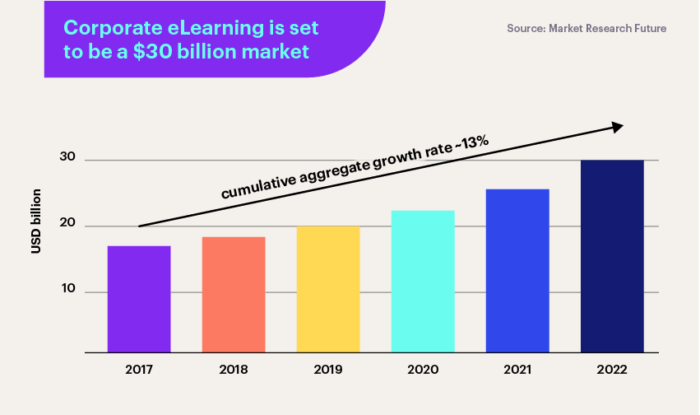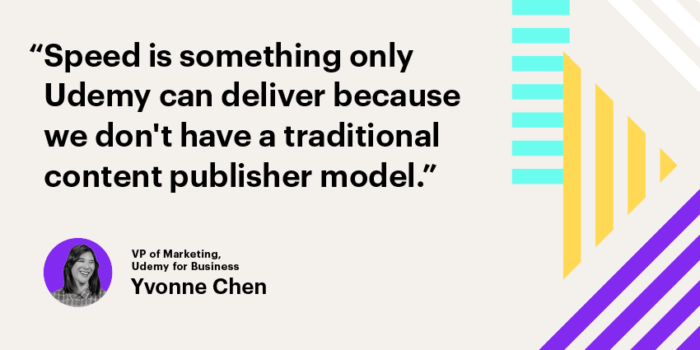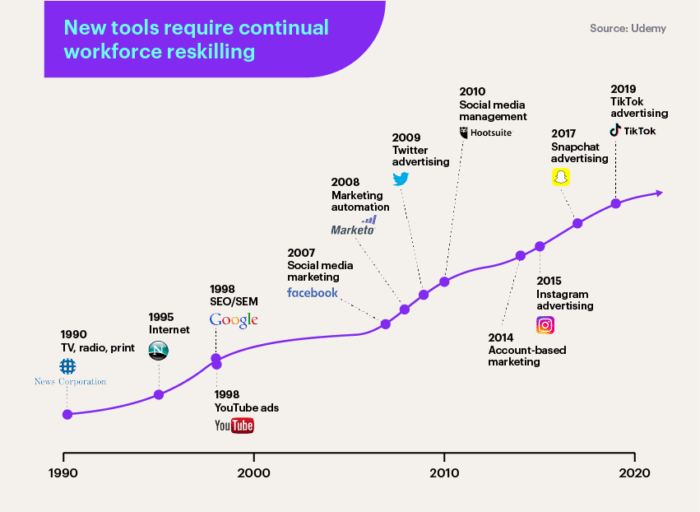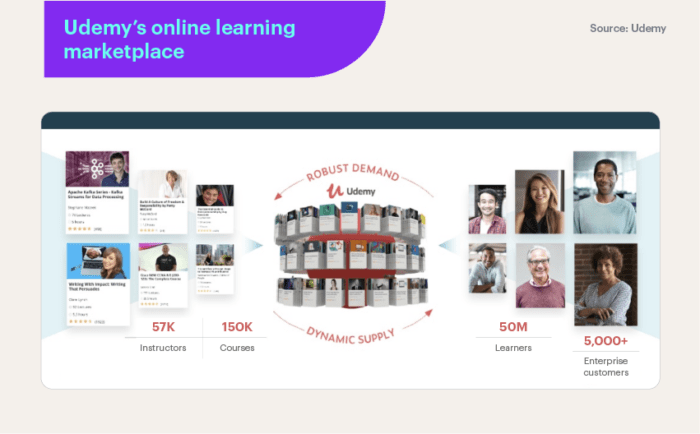
From marketplace to SaaS business: How Udemy acquired 80% of the Fortune 100
If you want to build a B2B SaaS business on top of an already hugely successful consumer marketplace, you need to do a lot more than hang a new welcome sign on your homepage.
The shift from serving just consumers to serving consumers and companies is a massive one. The story you tell to the market, the competitive moats you build, the pricing models fueling your growth – everything that got you to where you are needs to be reimagined for your new buyer. It might be the same core product, but it’s a completely different strategy.
“The shift from serving just consumers to serving consumers and companies is a massive one”
For Udemy, investing in a B2B arm seemed too obvious, and too good, an opportunity to ignore. Seeing a real demand for business courses in their consumer marketplace, the team identified an opening in the market to disrupt corporate training and hypothesized that employers would be more than willing to pay. And so in 2014, the marketplace launched Udemy for Business with an eye on acquiring corporations alongside the nearly two million learners they had at the time.
What started off as little more than an experiment has paid dividends. Today Udemy boasts 80% of the Fortune 100 – the top 100 largest US companies by revenue – as customers. In 2019 research firm IDC found Udemy for Business to deliver 869% ROI (🤯) along with time savings and higher productivity. And the opportunity ahead is only getting bigger. Analysts estimate that by 2022, global corporate eLearning will grow to be a $30 billion market.

At the helm of Udemy for Business’ customer acquisition machine is their VP of Marketing Yvonne Chen. When Yvonne joined in 2016, the business unit consisted of just 10 people across product, engineering, sales, and marketing. Since then, she’s helped grow Udemy’s B2B SaaS arm to more than 5,000 enterprise customers, which include the likes of Pinterest, Adidas, and General Mills.
Our Senior Director of Demand Generation Brian Kotlyar recently spoke with Yvonne about her experience scaling Udemy for Business. She shares why their success required embracing – not disavowing – the marketplace, what she considers when expanding internationally, and how she leverages feedback loops to balance supply and demand.
Listen to the full episode or check out Yvonne’s key takeaways below.
This is Season Two of Scale, Intercom’s podcast series on moving from startup to scale-up. If you enjoy the conversation and don’t want to miss the rest of the series, just hit subscribe on iTunes, stream on Spotify, Stitcher, or grab the RSS feed in your player of choice.
Turning a sales objection into a unique differentiator
When Eren Bali founded Udemy in 2010, he had a vision for what the marketplace would be: a place where anyone could teach and learn anything. You could take a course on how to play guitar, paint with watercolors, create a website, or build your own mobile app – all in one place.
But as Udemy started selling to businesses, the proliferation of choice that made them so popular with consumers suddenly became an obstacle to overcome. Prospects were confused over how the marketplace worked and the sales team struggled to explain it. Competitors seized on this, arguing – incorrectly, as it turned out – that because Udemy relied on user-generated content, they weren’t vetting their courses.
Yvonne swiftly flipped this story on its head. Rather than shying away from the marketplace, she embraced it as Udemy for Business’ unique differentiator. Only this time she focused on speed instead of choice. Yvonne describes it as “skills at the speed of the market.” And it’s an advantage that traditional corporate learning platforms simply can’t replicate.

Here’s Yvonne on how she positions Udemy for Business:
“What the marketplace allows us to do is, because we source expert content from everywhere around the world, actually get course content, really, really amazing course content, taught by really gifted experts around the world the moment that a particular technology or whatever it may be hits the market.
“That speed is something that only Udemy can deliver because we don’t have a traditional content publisher model that we follow. That speed to market is our huge competitive advantage, and that’s something that is really hard for our competitors to duplicate.”
Yvonne hasn’t just crystallized Udemy for Business’ core value proposition. She’s also identified a much bigger trend happening in the world of work that plays to the business unit’s strengths. Last year Deloitte reported that the half-life of skills has fallen to five years, meaning the average person will need to retrain or reskill up to 10 times over the course of their working lives.
Just look at the world of marketing: there are now more than 7,000 tools, up from a mere 150 in 2011. If you’re a digital marketer, nearly every year brings a new advertising channel to master, from Facebook and Twitter in the late 2000s to Snapchat and TikTok more recently.

Udemy for Business’ speed to market puts them at a distinct advantage in today’s world. When a new technology launches, the company’s community of instructors typically publishes a course on it, either months in advance or on the day of. Yvonne explains:
“In today’s world, you have to learn something new every day. There’s a new technology, there’s a new way of doing something, there’s some new analytics tool, there’s a new programming language that allows you to do something more efficiently.
“So, one example of that: when Apple launches the new iOS version every single year, Udemy usually has a course on how to use that new iOS version a couple of months in advance. Or it comes out the day that that new iOS version is announced. That’s the case for a lot of the new technology that comes out.”
A localized approach to growing internationally
For high-growth companies, international expansion signals a significant step change. It’s no secret that businesses can only grow as big as the market they’re in. Eventually they’ll have to make the choice between becoming a big fish in a small pond or adventuring into unfamiliar seas.
“Businesses can only grow as big as the market they are in”
Expanding beyond your home market isn’t a move to be made hastily, however. As Balderton Capital’s Rob Moffat points out going international too early can end up curtailing your company’s growth. Vacation rental marketplace Housetrip miscalculated the importance of word of mouth and, facing strong competition and high acquisition costs, was forced to scale back to two markets.
Yvonne has taken a data-driven approach to international expansion, successfully avoiding the traps that have ensnared other startups. Leveraging data from both the B2C and B2B sides, she examines each market closely before launching a course collection in a new language – using quantitative signals like pipeline growth along with qualitative feedback from sales reps.
“In terms of what languages we actually go after, it’s mostly dictated by demand. So what are the learners demanding on the marketplace? Have we seen a huge growth in users that have signed up coming from Germany, for example? Then we look at that on the business side too. So did we have large numbers of businesses in Germany or in Spain signing up to learn more about Udemy for Business or visiting our website multiple times over the last couple of months? If that’s the case then we need to talk to our go-to-market teams, our sales and customer success teams, to understand, ‘Hey, what are you running into in the market?’
“Specifically on the B2B side, we’re also looking at where has the business come from and where are we seeing revenue and pipeline popping? Those tend to happen in specific regions across the Europe, Middle East, and Africa markets. So that’s also how we’re determining what languages we’re going to start packaging up.”
Once the decision has been made to pursue a new language, Udemy’s marketplace means actually creating the content benefits from the same speed to market. Yvonne and her team are able to tap into Udemy’s network of more than 57,000 instructors and recruit local subject matter experts to teach business courses in their native languages.

Here’s Yvonne on Udemy for Business’ unique advantage when it comes to localizing course content:
“Because we have this vast marketplace, we’re actually in a really great position to offer local content to local audiences. So what I mean by that is because so many of our learners are international and because so many of our instructors are international, they are native speakers in their languages. So a German instructor is going to teach a technology course or a soft skills course on presentation skills in their native language, in German.
“That is something that a lot of other companies have struggled to do. A lot of companies have to rely on dubbing and captions to provide a better learning experience locally. We’re actually able to acquire really, really great content taught natively in that language on top of us also creating captions in different languages.”
A feedback loop to balance supply and demand
Marketplaces are notoriously difficult to manage and scale. They suffer from the chicken-or-egg problem: do you invest in acquiring buyers or sellers first? Neglect either and you’re left with a pool of dissatisfied users with nothing to exchange on your platform.
Ebay was among the first online marketplaces to crack the problem. Seeing nearly exponential growth for the first decade, Ebay quickly transformed from a site for trading collectibles to a multibillion dollar tech behemoth. Their secret? Strategically matching buyers and sellers at the microlevel, according to early employee Janet Bannister.
Udemy for Business has taken a similar approach to balancing its supply – instructors – and demand – in their case, businesses. While businesses pay for a subscription, altering the typical marketplace dynamics, Yvonne and her team are still keen to ensure the trends they’re seeing on the B2B side are met with the right kinds of content.

Yvonne is able to tap into a sophisticated feedback loop, designed to monitor topic and skills trends by market. Signals like search queries and volume enable Udemy’s content team to hone in on imbalances in course content and interest from learners. The patterns Yvonne and the team see on the B2C side often foreshadow behavior on the B2B side.
“We actually have tools internally that we’ve developed and dashboards that we’ve developed internally where we can actually look at trends month over month, quarter over quarter. So those are regular metrics that we are looking at all the time. The most amazing part about our business is we are direct-to-consumer. We’re also B2B. A lot of the pops and the trends that happen across consumers around the world are, a lot of times, indicative of the pops and the trends that we’re going to see on the B2B side.
“We do a lot of SQL querying to look at what are the terms and the things that people are actually searching for when they’re on Udemy. So that’s the system we’ve developed on the content side to really understand what’s actually happening. And then what are the new topics and skills that we need to be prepared for?”

Sophisticated marketplaces will often build self-service tools to optimize the supply side. Sellers are naturally incentivized to maximize their own revenue, after all. That’s what tools like Lyft’s hot spots, which shows where passengers are concentrated, and Airbnb’s pricing insights, which prompts hosts to adjust their pricing, bank on.
Udemy has their own version for instructors: Marketplace Insights. This tool unearths gaps in content for a particular skill or subject matter. Combined with the relationships the Udemy for Business team have with individual instructors, the B2B business unit is able to quickly deliver on demands for new courses from their enterprise customers. Yvonne elaborates:
“[Marketplace Insights] will actually tell them: this is the growth in this topic in the last couple of weeks or whatever time period you might be looking at the data for. This is how many searches occurred, this is how many courses exist in this topic area. Then we’ll actually give them recommendations and we’ll say, ‘Actually, the marketplace is actually short on content here. We recommend that you create a course, and this is the price that you could potentially charge for that course. This is how much potential revenue you might make from it if you were to add it into the marketplace.’
“If we see a particular topic or skill popping in terms of demand and we don’t see that supply happening on the marketplace, we will actually reach out to our top instructors in those skill areas and we’ll tell them. We’ll say, ‘Hey, guess what? We think that you’d be great at teaching this skill. This skill grew in popularity by 80% in the last couple of months. Is this something that you can do?’”
This post is part of Scale, a place where we explore how businesses are driving growth through customer relationships. Scale offers advice and guidance from support, marketing, and sales leaders who are charting new paths for their customers – and their companies.







